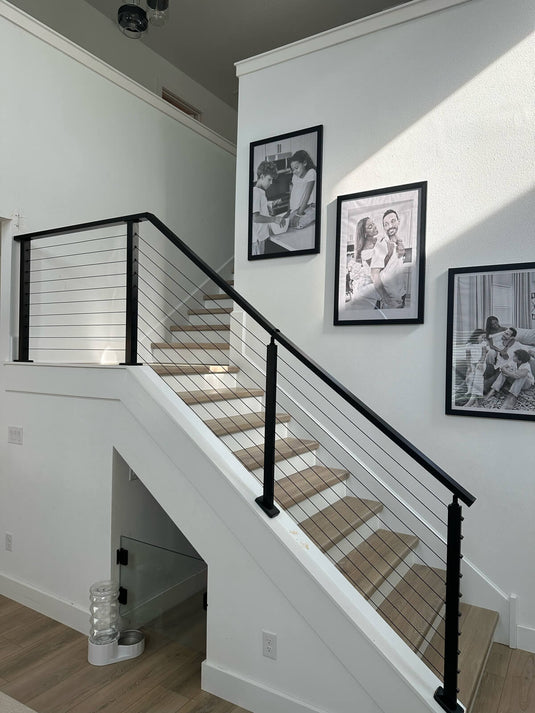TABLE OF CONTENTS
How to Select the Perfect Stainless Steel Cable Railing Posts for Your Deck?
Choosing the right railing system is crucial for aesthetics and safety when designing or renovating a deck. Stainless steel cable railing posts have become a popular option due to their sleek and modern look, strength, and low maintenance requirements. However, several factors should be considered when selecting posts to ensure they perfectly suit your environment, design style, and structural needs. This guide covers the key considerations when choosing the ideal stainless steel cable railing posts for your deck.

Assess the Environment
The specific environmental conditions that a deck is exposed to should inform the decision on which grade of stainless steel to choose for the cable railing posts. Coastal areas with saltwater spray or inland regions with substantial rainfall and humidity require maximum corrosion protection. Marine-grade 316 stainless steel contains 2-3% molybdenum, significantly enhancing corrosion resistance and durability compared to basic 304 grades.
The added molybdenum increases resistance to chloride attack from salty sea spray or deicing salts. As such, 316 is the best choice for coastal decks to prevent rust and lasts two to four times longer than 304 stainless steel. While 316 stainless comes at a 25-50% premium in cost over 304, it is a sound long-term investment that pays off through decades of durability in harsh oceanfront conditions with minimal maintenance beyond occasional cleaning.
In protected inland environments with lower humidity and less exposure to moisture, 304 stainless steel potentially provides adequate lifespan and corrosion protection at a lower initial cost. 304 contains 18% chromium and 8% nickel for reasonable corrosion performance. Evaluate factors like annual rainfall, proximity to roads treated with corrosive deicing salts that can waft onto the deck, and predominant wind direction before deciding between 304 and 316 stainless. Consult manufacturers’ recommendations and local building codes as well.
Choose the Design Style
Start by taking into account the existing architecture and design elements of your home or deck space when selecting cable railing posts. Sleek, narrow posts fabricated from stainless steel tubing with clean welds and lines tend to blend almost seamlessly into modern glass railings and contemporary design features. If your deck showcases ornate woodwork, carved concrete accents, or a traditionally styled exterior palette, consider expanded metal mesh panels or solid, decorative posts to match the robust traditional look.
The shape of the posts also impacts the overall style and feel. Round posts with a hand-polished mirror finish nicely accentuate the contemporary vibe of adjacent glass panel railings or sleek tiles. Square stainless posts deliver a sturdy, industrial look that is fitting for traditional and arts & crafts-inspired homes. For those desiring a custom look, decorative post caps and collars can add unique personality. Ultimately, the cable railing posts should harmonize beautifully with the existing deck aesthetics rather than look conspicuously out of place. Carefully consider the options to enhance the space.
Select the Finish
The nature of the surface finish performs a critical role in determining the overall look of stainless steel cable railing posts and their durability. A lightly brushed finish adds a subtle uniform texture through fine abrasive buffing. It hides minor fingerprints and water spots while avoiding a plastic-like look. Highly polished mirror finishes utilize progressive abrasives to maximize luster and light reflection, accentuating contemporary glass features.
However, fingerprints and water spots show plainly on polished stainless without diligent cleaning. Powder-coated finishes offer unlimited color choices, from neutral tones to vibrant colors to match deck accents. However, scratches can expose the base stainless below.
Weigh maintenance considerations - while polished finishes best resist corrosion brushed hides imperfections. Ensure accessibility for periodic upkeep. Also, consider which finish best highlights or recedes into the surroundings to align with your intended ambiance, whether sleekly modern or decoratively ornate traditional.
Consider Post Size and Thickness
A key structural consideration in any cable railing system is managing the substantial tension forces exerted along the length of the taut horizontal cable runs. As the distance or span between vertical cable railing posts increases, the lateral tension forces also rise exponentially. Thicker posts become necessary to resist bending deflection without permanent damage or premature failure over time when subjected to higher tension loads over longer spans.
Likewise, thicker 1/4 inch diameter cable applies greater point force than 3/16 inch cable when pulled equally taut. Thus, for wider sections of the deck, stairways, or curved designs subject to higher tension forces, specifying appropriately thicker posts and larger diameter tubing avoids excessive stress and an unsightly wavy appearance from cables pulling posts sideways.
Consult an engineer for precise structural specifications accounting for cable tension loads and desired span lengths. As a general rule of thumb, however, taller 42-inch posts should have a larger outer diameter than shorter 36-inch posts to maintain adequate rigidity. Anything over 6 feet wide typically requires 3-inch diameter posts for sufficient stiffness. Anything under 36 inches can utilize thinner 2-inch tubing. The key lies in balancing optimal structural integrity without overdesigning thick posts that visually overwhelm the railing aesthetics. Seek the thinnest viable size satisfying engineering requirements.

Evaluate Mounting Options
The method that stainless steel posts mount onto the deck itself - whether top mounted directly to the horizontal surface or side mounted vertically along the outer deck perimeter - carries pros and cons related to appearance and installation factors. Surface mounting typically provides the cleanest look, with posts simply bolted onto the deck boards or pavers using embedded anchors or backup plates underneath. No visible brackets detract from the sleek minimalist style. However, retrofitting surface mounting requires installing subsurface supports like poured concrete footings.
For existing decks where subsurface modifications prove difficult, side mounting offers an alternative. Posts bolt laterally into the outer deck framing rim board or stair risers. While the mount brackets remain visible, no deck substructure alterations are necessary. Side mounting also allows posts to be secured closer to railing terminals around corners.
Ultimately, the best method depends on your deck layout, style preferences, and whether it is new construction or renovation. Ensure the approach properly supports the cable tension loads and stylistically fits your vision. Consult an engineer to confirm structural soundness as well.
Cable Compatibility
Verifying cable system compatibility represents another key consideration when selecting stainless steel posts. Structural cables are commonly available in 3/16 and 1/4-inch diameters. Accordingly, posts must be designed with appropriately sized internal channels, holes, or edge slots to securely receive the chosen cable thickness while allowing for tension adjustments during professional installation.
Reputable manufacturers offer CAD details showing cable hole sizing and spacing dimensions relative to post width and height to guide compatibility checks prior to purchase. Take careful field measurements of your planned post locations and span layouts as a reference. Double-check that the post-hole patterns precisely match the cable runs to avoid problems. Ensuring everything aligns upfront prevents headaches later.
Comply With Building Codes
Adhere to local building codes and zoning laws governing deck railing height, baluster spacing, and structural integrity to promote safety. While requirements vary among regions, many mandate a minimum height of 36 or 42 inches for deck railings. Likewise, baluster spacing often cannot exceed 4 inches clear. Have posts and cables designed to satisfy applicable building codes. Consider consulting an engineer.

Consider Top Rail Options
While some contemporary deck railing designs utilize stainless steel cables alone sans a top rail for an unfettered view, most local building codes require a minimum barrier height that necessitates including a graspable upper handrail for occupant safety. However visually obtrusive, a structural top rail represents an additional safety barrier able to sustain lateral impact loads to mitigate fall hazards.
Further, including a coordinating steel tube or rectangular channel rail atop the cable infill provides a strengthened attachment point between posts to resist cable tension forces better. This extra structural connection between posts also allows extending post spans beyond 6 feet without compromising strength. For long stairway runs, incorporating a top rail significantly boosts rigidity.
Some still prefer a sleek, rail-less modern design allowing unobstructed outward views in areas where codes permit. Assess your planned viewsheds and whether including an upper stainless tube interrupts the sight lines. Additionally, consider your risk tolerance for potential safety impacts. Depending on budget, preferences, location above grade, and governing codes - weighing the structural and safety merits against desired views remains essential when deciding on adding a top rail. Regardless, ensure that the railing height meets the requirements.
Balance Budget and Quality
It is often said in construction that one gets what they pay for, with the stainless steel railing materials market being no exception. More expensive 316-grade stainless posts fabricated from higher nickel content alloys significantly outlast cheaper 304-grade posts in harsh coastal and winter environments. However, the 25-50% price premium over 304 stainless gives pause to some homeowners trying to balance costs. But those initially saved dollars turn into frequent maintenance headaches later.
Whereas properly designed marine-grade 316 stainless resists corrosion and maintains its luster for decades largely carefree, lower-cost 304 posts often exhibit surface rust staining within a couple of years when exposed to humidity, chlorides, acids, or deicing salts. This leads to premature replacement - frequently before homeowners receive any reasonable return on their initial investment. From a total lifecycle cost perspective, a higher upfront cost for 316 stainless cable railing hardware equates to better value and fewer repairs down the road. Consult manufacturers’ warranties when evaluating budget and anticipated longevity.
Seek Reviews and References
Seeking third-party reviews and referrals helps properly vet prospective stainless cable railing system companies prior to purchase. Online customer testimonials, along with photos of past residential installations, serve to endorse the quality of materials and workmanship companies provide to homeowners. Additionally, asking manufacturers to supply project references, such as recent clients, offers the ability to ask about and potentially see the installed products directly after some period of use.
This provides helpful insight regarding how the posts and cabling have held up over time when subject to real-world conditions. Carefully examine the finishes and hardware for early signs of corrosion or structural issues. Getting a sense of whether corners were cut or materials meet quality standards aids decision-making. Lastly, cross-checking referrals using third-party review sites helps corroborate any claims. Reviewing as much independent feedback as possible enables proper evaluation of companies.
Final Words
Choosing the ideal stainless steel cable railing posts to match your deck begins by carefully evaluating the environment, intended design style, structural requirements, safety codes, and budget. Selecting the proper shape, size, grade of stainless steel, and finish results in cable railing posts that reliably serve their function safely while enhancing outdoor living with contemporary beauty for years to come. Properly designed and installed, cable railing posts become an invaluable asset that elegantly complements your deck or patio.




